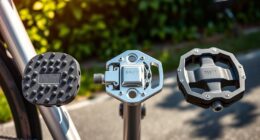When planning your first long-distance bike trip, choose the right bike—think touring, endurance road, or mountain bikes based on your needs. Plan your route with tools like Google Maps for elevation and bike-friendly paths. Start training three to four days a week for at least 12 weeks, focusing on building your aerobic base. Budget for gear, food, and potential emergencies. Don't forget safety equipment like helmets and lights. There's so much more to discover about making your trip a success.
Key Takeaways
- Choose the right bike type based on your terrain and load needs, ensuring a proper fit for comfort and efficiency.
- Plan your route using tools like Google Maps and Komoot, considering elevation, traffic, and local attractions.
- Start training at least 12 weeks in advance, focusing on building endurance through consistent rides and cross-training.
- Budget for gear, food, and transportation, while setting aside emergency funds for unexpected costs along the trip.
- Prioritize safety by investing in protective gear, ensuring bike visibility, and carrying a first aid kit for emergencies.
Choosing the Right Bike
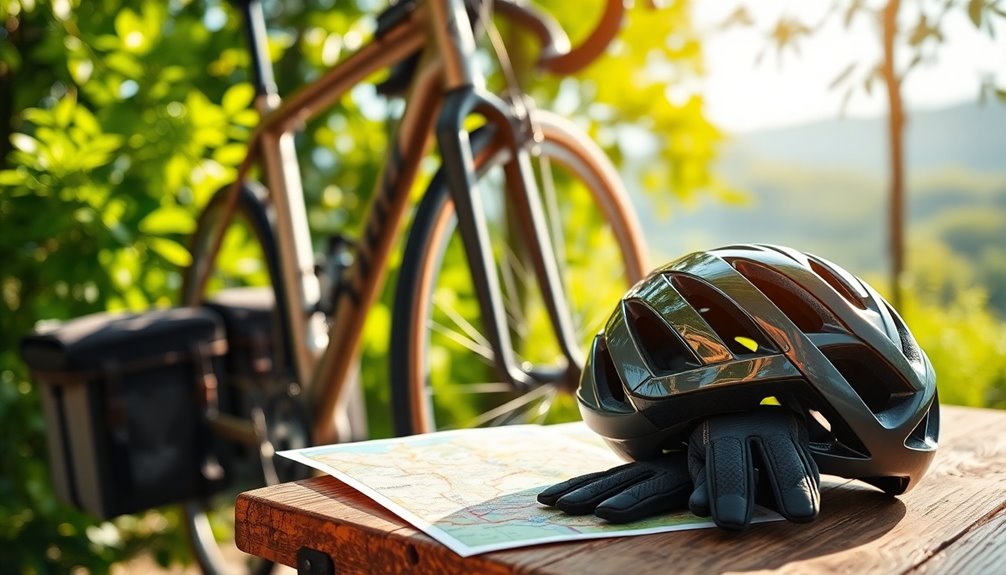
When you're planning your first long-distance bike trip, choosing the right bike is crucial for ensuring a comfortable ride.
Consider a touring bike for its robust frame and wide gear range, perfect for carrying heavy loads. If you prefer paved roads, an endurance road bike offers comfort and efficiency. For off-road adventures, a mountain bike provides the suspension and durability you need, while an e-bike can ease physical strain with pedal assistance. Hybrid bikes are great for mixed terrains.
Pay attention to frame materials like aluminum for lightweight durability or steel for comfort. Ensure a proper fit with appropriate saddle height and handlebar reach to prevent injuries and enhance performance on your journey.
Planning the Route

Now that you've chosen the right bike for your journey, the next step is planning your route. Start by using tools like Ride with GPS for turn-by-turn directions, or Google Maps to check elevation gains and bike-friendly paths.
If you prefer off-road trails, Komoot can help tailor routes for your cycling style. Don't overlook resources from the Adventure Cycling Association, which provides detailed long-distance maps.
While planning, consider terrain, traffic conditions, and local attractions along your route. It's smart to budget for unexpected detours too.
Lastly, review your route for hazards and ensure you've included waypoints. Testing parts of your route, if possible, can help you feel more prepared for your adventure. Additionally, be aware of potential state taxes on withdrawals that may impact your financial planning while on your trip.
Training and Preparation
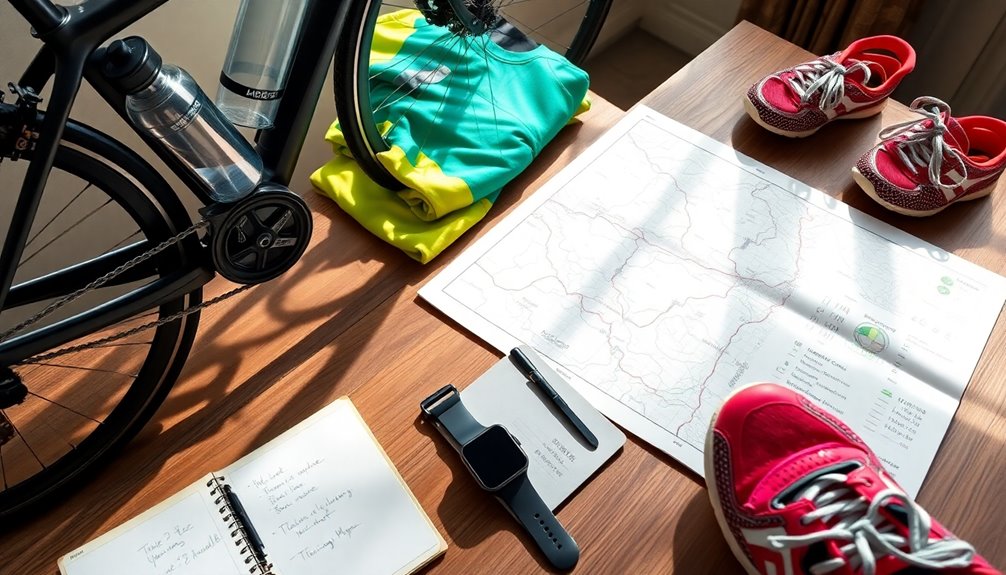
As you gear up for your long-distance bike trip, effective training and preparation are crucial to ensure your success and enjoyment.
Start training at least 12 weeks prior, riding three to four days a week. Focus on time over distance initially, incorporating steady-state rides at a cadence of 70 to 90 RPM. Gradually increase your ride duration and intensity.
Build your aerobic base and enhance cardiovascular fitness through cross-training activities like jogging or swimming. Don't forget strength training and flexibility exercises to prevent injuries.
Maintain a balanced diet rich in carbs, proteins, and healthy fats, and develop a hydration strategy.
Ensure your bike is well-maintained and properly fitted for maximum comfort on your journey.
Budgeting and Cost Management
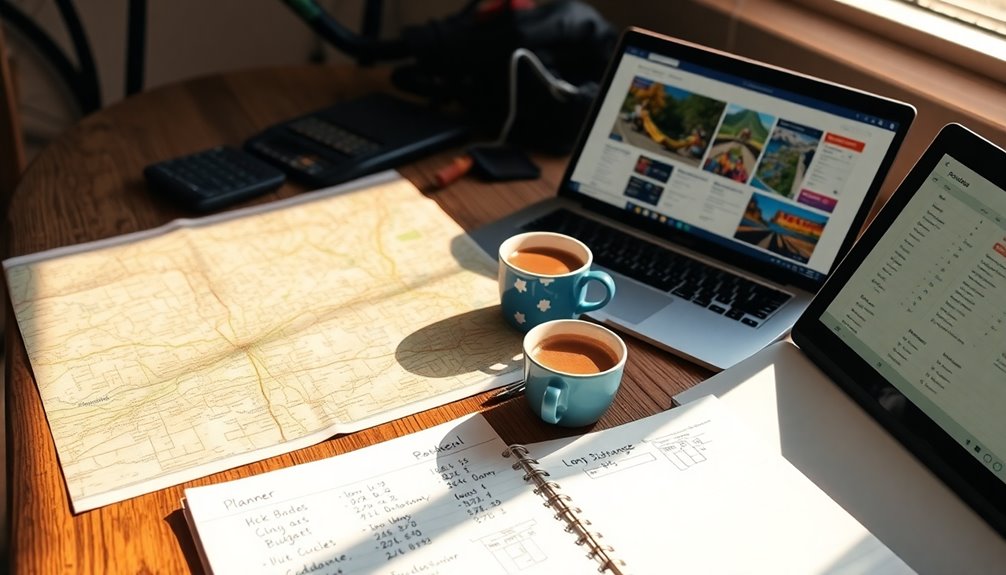
After you've laid the groundwork with training and preparation, it's time to tackle budgeting and cost management for your long-distance bike trip.
Start by considering your initial investment, which can range from $1,000 to $10,000 depending on your gear and bike choices. Join clubs like REI Co-Op for discounts, and utilize budgeting calculators to track expenses.
Camping is usually cheaper than hotels, and you can keep daily food costs around $15 by cooking meals. Don't forget to budget for transportation costs like shipping your bike or public transport.
Lastly, set aside emergency funds for unexpected expenses and remain flexible with your budget to adapt to changing circumstances. Smart planning ensures a smoother experience on your adventure! Additionally, consider establishing consistent routines to help manage any stress that may arise during your trip.
Safety and Emergency Planning
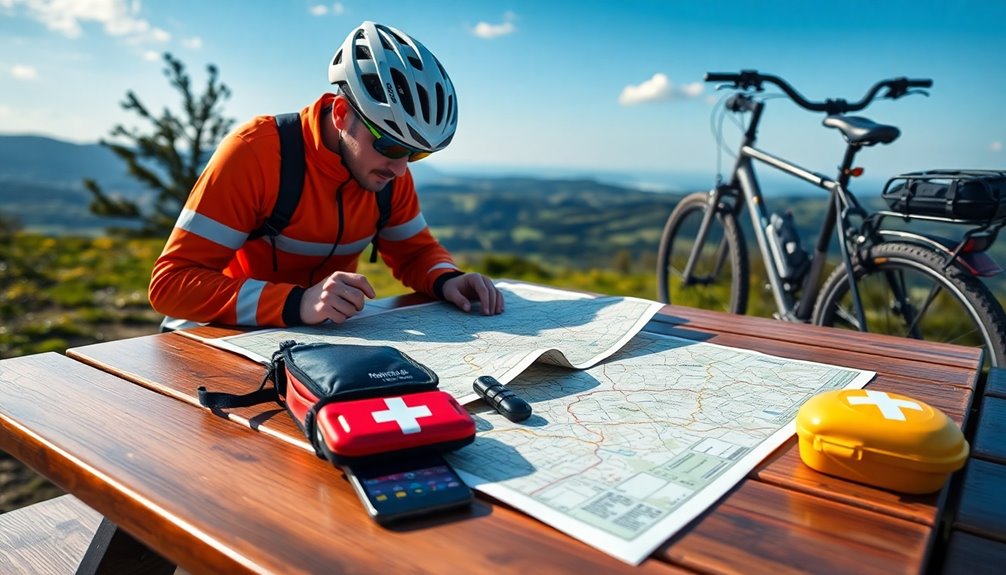
When planning your long-distance bike trip, prioritizing safety and emergency preparedness can make all the difference in your experience.
Start by investing in essential safety equipment like a certified helmet, high-visibility gear, and protective clothing. Ensure your bike lights and signals work correctly to enhance visibility.
Scout your route to avoid busy roads and plan for regular rest stops. Keep a basic first aid kit and learn basic bike repairs to manage potential issues.
Carry a list of emergency contacts and consider a roadside assistance plan for unexpected breakdowns. Utilize GPS for navigation and, if you're heading to remote areas, a personal locator beacon can be invaluable.
Staying hydrated and maintaining physical conditioning will keep you focused on the road ahead. Additionally, think about the cleaning technology of your gear, as ensuring your equipment is in top shape can prevent accidents and improve your overall experience.
Logistics and Support
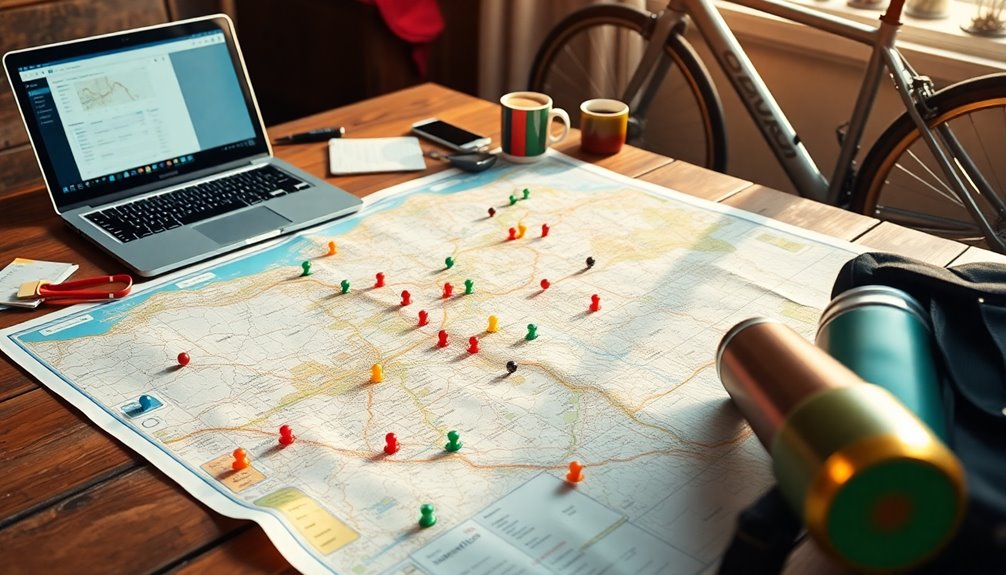
Planning a long-distance bike trip requires careful consideration of logistics and support to ensure a smooth journey. Start by selecting a reliable route, like those from the Adventure Cycling Association, and consider terrain and resupply points for food and water.
It's wise to consult locals for current road conditions and have bail-out options in emergencies.
Choose a comfortable bike, ideally with a durable steel frame, and ensure it's well-maintained with new brakes and essential spares.
For transportation, sturdy bike racks are crucial, so opt for hitch-mounted options for security.
Finally, consider your accommodation choices—camping saves money, but booking hotels in advance can help with budgeting.
Engage with local cyclists for insights and utilize online resources for planning.
Frequently Asked Questions
What Should I Pack for a Long-Distance Bike Trip?
When you're packing for a long-distance bike trip, focus on comfort and safety.
Make sure you've got a helmet, hydration pack, and a reliable route map. Don't forget your cycling jersey and shorts, along with bike shoes and socks.
Bring essential bike accessories like panniers, a headlight, and a lock.
Lastly, pack important documents, cash, and a basic first aid kit. This way, you'll be well-prepared for whatever your journey throws at you.
How Do I Handle Bike Repairs on the Road?
Ah, the thrill of bike repairs! You'll love fumbling with tools while hoping the universe doesn't conspire against you.
First, pack a basic toolkit and spare parts; they're your best friends. Learn tire changes and chain adjustments—they're like bike CPR.
Regular maintenance prevents surprises, unless you enjoy surprises.
Lastly, scout bike shops along your route, because nothing says "fun" like a spontaneous repair adventure.
Enjoy the ride, and may your tires stay inflated!
What Should I Do if I Get Lost?
If you get lost, stay calm and assess your surroundings.
Retrace your steps to the last known point if possible. Use your maps or GPS to determine your current location and find a way back.
Look for landmarks or road signs to guide you. Don't hesitate to ask locals or fellow cyclists for directions.
If necessary, adjust your route so you can continue safely and enjoy your ride.
Can I Bring My Pet on the Trip?
Did you know that 56% of pet owners consider their pets family members?
If you're thinking about bringing your pet on your trip, it's crucial to prioritize their safety and comfort. Smaller dogs can ride in carriers, but make sure they're acclimated beforehand.
Check local regulations, pack essentials, and ensure they're healthy enough for travel. Regular breaks for hydration and rest will keep both of you happy on the journey!
How Do I Choose the Right Clothing for Cycling?
When you choose cycling clothing, focus on comfort and performance.
Look for moisture-wicking fabrics to keep you dry and breathable materials for airflow. Make sure your clothing fits well to avoid safety hazards and chafing; padded shorts can enhance comfort.
Opt for bright colors or reflective elements to stay visible, especially in low light.
Layering can help you adapt to changing weather, ensuring you're prepared for any conditions you encounter.
Conclusion
With the right bike and a well-planned route, your first long-distance bike trip can feel like an epic adventure worthy of legends. By training hard, budgeting wisely, and preparing for any emergencies, you'll ensure every pedal stroke brings you closer to unforgettable memories. Embrace the journey, relish the challenges, and don't forget to enjoy the breathtaking views along the way. So gear up, hit the road, and let the ride of a lifetime begin!









